Measuring Trajectories¶
Sire has in-built support for trajectories. This allows you to measure bonds, angles, dihedrals and other properties for across a range of frames of a trajectory. This can be useful to see how these measurements changed during, e.g. a molecular dynamics simulation.
For example, let’s load a trajectory contained in a DCD file.
>>> import sire as sr
>>> mols = sr.load(sr.expand(sr.tutorial_url, ["h7n9.pdb", "h7n9.dcd"]))
>>> mol = mols[0]
>>> print(mol.num_frames())
501
You load trajectories in the same way as you load any other molecular file
in Sire. Just add the trajectory file (here h7n9.dcd) to the list of
files to load. The file type will be determined automatically, and the
trajectory frames loaded in order (e.g. if you pass in multiple trajectory
files to load).
Sire recognises two main types of molecular data;
Topology data - this is information about the structure or topology of the molecules, e.g. how the atoms divide into residues, and how these divide across molecules.
Frame data - this is information that is specific to an individual trajectory frame, e.g. coordinates, velocities, space and time information.
Individual molecular input files contain topology data and/or frame data.
In this case, h7n9.pdb contains both topology and frame data, while
h7n9.dcd contains just frame data.
Sire will load the topology information from the first file in the list
of files that contains topology information (e.g. h7n9.pdb). It will
then load frames in order from all files that contain frame data
(so both h7n9.pdb and h7n9.dcd).
In this case, 501 frames have been loaded. These are the one frame from
h7n9.pdb, which is the first frame. And then the next 500 frames
are the five hundred loaded from h7n9.dcd.
In many cases you would only want to analyse the trajectory data contained
in the DCD file, and would not be interested in the frame data from the
PDB file. We can remove this frame data using the delete_frame function,
e.g.
>>> mol.delete_frame(0)
>>> print(mol.num_frames())
500
Iterating over trajectories¶
You iterate over the frames in a trajectory using a
sire.mol.TrajectoryIterator that is returned by the
.trajectory() function.
For example, here we will iterate over all 500 frames and just print out the first atom of the molecule.
>>> for frame in mol.trajectory():
... print(frame[0])
Atom( N:1 [ 15.62, 42.18, 15.18] )
Atom( N:1 [ 15.24, 43.24, 15.65] )
Atom( N:1 [ 15.05, 42.39, 15.22] )
Atom( N:1 [ 16.16, 41.74, 14.25] )
Atom( N:1 [ 16.62, 41.16, 15.16] )
Atom( N:1 [ 14.37, 42.47, 15.84] )
Atom( N:1 [ 16.63, 42.29, 13.91] )
... etc.
You can call .trajectory() to iterate over any view of a molecule
(or views of molecules). For example, we could loop over the first
atom directly,
>>> for atom_frame in mol[0].trajectory():
... print(atom_frame)
Atom( N:1 [ 15.62, 42.18, 15.18] )
Atom( N:1 [ 15.24, 43.24, 15.65] )
Atom( N:1 [ 15.05, 42.39, 15.22] )
Atom( N:1 [ 16.16, 41.74, 14.25] )
Atom( N:1 [ 16.62, 41.16, 15.16] )
Atom( N:1 [ 14.37, 42.47, 15.84] )
Atom( N:1 [ 16.63, 42.29, 13.91] )
... etc.
or we could loop over the frames of the first residue, print out its center of mass coordinates;
>>> for res_frame in mol.residue(0).trajectory():
... print(res_frame, res_frame.coordinates())
Residue( ARG:1 num_atoms=26 ) ( 14.7759 Å, 42.2632 Å, 18.201 Å )
Residue( ARG:1 num_atoms=26 ) ( 14.368 Å, 43.886 Å, 18.7757 Å )
Residue( ARG:1 num_atoms=26 ) ( 14.3506 Å, 42.9594 Å, 18.359 Å )
Residue( ARG:1 num_atoms=26 ) ( 15.4561 Å, 41.4458 Å, 17.4479 Å )
Residue( ARG:1 num_atoms=26 ) ( 15.3717 Å, 41.1966 Å, 18.1695 Å )
Residue( ARG:1 num_atoms=26 ) ( 13.4568 Å, 43.847 Å, 18.778 Å )
Residue( ARG:1 num_atoms=26 ) ( 15.1335 Å, 43.0555 Å, 17.4046 Å )
etc.
The TrajectoryIterator is itself indexable. This allows
you to slice the frames that are iterated over. Here, we will iterate
over just the first 5 frames of the trajectory
>>> for res_frame in mol.residue(0).trajectory()[0:5]:
... print(res_frame, res_frame.coordinates())
Residue( ARG:1 num_atoms=26 ) ( 14.7759 Å, 42.2632 Å, 18.201 Å )
Residue( ARG:1 num_atoms=26 ) ( 14.368 Å, 43.886 Å, 18.7757 Å )
Residue( ARG:1 num_atoms=26 ) ( 14.3506 Å, 42.9594 Å, 18.359 Å )
Residue( ARG:1 num_atoms=26 ) ( 15.4561 Å, 41.4458 Å, 17.4479 Å )
Residue( ARG:1 num_atoms=26 ) ( 15.3717 Å, 41.1966 Å, 18.1695 Å )
Measuring RMSD across a trajectory¶
You can measure the root mean square deviation (RMSD) across a trajectory
using the rmsd() function.
>>> print(mol.trajectory().rmsd())
[0 ,
1.11524 Å,
1.11777 Å,
1.68127 Å,
2.00073 Å,
...
2.17744 Å,
2.05558 Å,
2.15149 Å,
2.14664 Å]
You can calculate the RMSD for specific frames by slicing or indexing.
>>> print(mol.trajectory()[0:5].rmsd())
[0 , 1.11524 Å, 1.11777 Å, 1.68127 Å, 2.00073 Å]
would print the RMSD over the first 5 frames. While
>>> print(mol.trajectory()[ [0, 2, 4, 6 ]].rmsd())
[0 , 1.11777 Å, 2.00073 Å, 1.94698 Å]
prints the RMSD for frames 0, 2, 4 and 6.
By default, the RMSD is calculated against the first frame. You can control
the frame via the frame argument. For example, here we will print
out the RMSD of the last 5 frames, measured against the last frame.
>>> print(mol.trajectory()[-5:].rmsd(frame=-1))
[1.57051 Å, 1.54928 Å, 1.16827 Å, 1.20729 Å, 0 ]
By default, the RMSD is calculated for all atoms in the view. You can specify a subset using either a search string, e.g.
>>> print(mol.trajectory()[0:5].rmsd("element C"))
[0 , 0.855642 Å, 0.817883 Å, 1.022 Å, 1.04215 Å]
would calculate the RMSD only for the carbon atoms. Note that this
aligns each frame of the trajectory against the reference. You can control
this using the align argument, e.g. by turning this off.
>>> print(mol.trajectory()[0:5].rmsd("element C", align=False))
[0 , 0.85613 Å, 0.818511 Å, 1.02247 Å, 1.04229 Å]
Note
If align is not set, then it defaults to True for RMSD
calculations for a specified subset of atoms, or for RMSDs
calculate over all atoms when there are less than 100 molecules.
Otherwise, it is set to False.
You can also calculate the RMSD against a view, e.g.
>>> print(mol.trajectory()[0:5].rmsd(mol.atoms()[0:10]))
[1.31649 Å, 0.992494 Å, 1.0131 Å, 0.966568 Å, 0.986925 Å]
calculates the RMSD over the first 10 atoms.
Note that you will need to supply an atom mapping if the atoms in the RMSD reference are not in the trajectory. More details of how to do this are in the mapping tutorial.
Measuring bond lengths over a trajectory¶
Bonds, Angles, Dihedrals and Impropers are also molecular views, and so you can iterate over their trajectories in the same way.
For example, the H7N9 protein contains a number of disulfide bonds.
We can find these bonds using
>>> print(mol.bonds("element S", "element S"))
SelectorBond( size=9
0: Bond( SG:177 => SG:5098 )
1: Bond( SG:672 => SG:735 )
2: Bond( SG:1479 => SG:1736 )
3: Bond( SG:1586 => SG:2317 )
4: Bond( SG:2343 => SG:2407 )
5: Bond( SG:3041 => SG:3217 )
6: Bond( SG:3062 => SG:3193 )
7: Bond( SG:3641 => SG:3905 )
8: Bond( SG:5163 => SG:5600 )
)
We can iterate over the trajectory frames for these bonds, and then
measure them. For example, lets iterate over the first ten frames of the
first S-S bond, and print it’s length.
>>> for bond_frame in mol.bonds("element S", "element S")[0].trajectory()[0:10]:
... print(bond_frame, bond_frame.measure())
Bond( SG:177 => SG:5098 ) 1.97428 Å
Bond( SG:177 => SG:5098 ) 2.12148 Å
Bond( SG:177 => SG:5098 ) 2.01916 Å
Bond( SG:177 => SG:5098 ) 2.03011 Å
Bond( SG:177 => SG:5098 ) 1.92681 Å
Bond( SG:177 => SG:5098 ) 2.05971 Å
Bond( SG:177 => SG:5098 ) 2.00386 Å
Bond( SG:177 => SG:5098 ) 1.9727 Å
Bond( SG:177 => SG:5098 ) 2.06847 Å
Bond( SG:177 => SG:5098 ) 1.98437 Å
We could have done this for all of the bonds, using…
>>> for bonds_frame in mol.bonds("element S", "element S").trajectory()[0:10]:
... print(bonds_frame, bonds_frame.measures())
SelectorBond( size=9
0: Bond( SG:177 => SG:5098 )
1: Bond( SG:672 => SG:735 )
2: Bond( SG:1479 => SG:1736 )
3: Bond( SG:1586 => SG:2317 )
4: Bond( SG:2343 => SG:2407 )
5: Bond( SG:3041 => SG:3217 )
6: Bond( SG:3062 => SG:3193 )
7: Bond( SG:3641 => SG:3905 )
8: Bond( SG:5163 => SG:5600 )
) [1.97428 Å, 2.03112 Å, 2.07281 Å, 2.0191 Å, 2.04427 Å, 2.06217 Å, 2.06375 Å, 1.98086 Å, 2.00846 Å]
SelectorBond( size=9
0: Bond( SG:177 => SG:5098 )
1: Bond( SG:672 => SG:735 )
2: Bond( SG:1479 => SG:1736 )
3: Bond( SG:1586 => SG:2317 )
4: Bond( SG:2343 => SG:2407 )
5: Bond( SG:3041 => SG:3217 )
6: Bond( SG:3062 => SG:3193 )
7: Bond( SG:3641 => SG:3905 )
8: Bond( SG:5163 => SG:5600 )
) [2.12148 Å, 2.02085 Å, 2.01314 Å, 2.02394 Å, 2.03679 Å, 2.05127 Å, 2.13314 Å, 2.09479 Å, 2.01281 Å]
SelectorBond( size=9
0: Bond( SG:177 => SG:5098 )
1: Bond( SG:672 => SG:735 )
2: Bond( SG:1479 => SG:1736 )
3: Bond( SG:1586 => SG:2317 )
4: Bond( SG:2343 => SG:2407 )
5: Bond( SG:3041 => SG:3217 )
6: Bond( SG:3062 => SG:3193 )
7: Bond( SG:3641 => SG:3905 )
8: Bond( SG:5163 => SG:5600 )
) [2.01916 Å, 2.07407 Å, 2.13044 Å, 2.05 Å, 1.94306 Å, 2.02388 Å, 1.99157 Å, 2.0498 Å, 2.11982 Å]
etc...
…but you can see that we quickly reach the limit of what can sensibly be printed to the screen.
Creating tables of measurements using pandas¶
To make things easier, the .measures() function on the
TrajectoryIterator will calculate all of the measures
across all of its frames, and will return the result as a dictionary.
>>> measurements = mol.bonds("element S", "element S").trajectory().measures()
>>> print(measurements)
{'frame': array([ 0, 1, 2, 3, 4, 5, 6, 7, 8, 9, 10, 11, 12,
13, 14, 15, 16, 17, 18, 19, 20, 21, 22, 23, 24, 25,
26, 27, 28, 29, 30, 31, 32, 33, 34, 35, 36, 37, 38,
39, 40, 41, 42, 43, 44, 45, 46, 47, 48, 49, 50, 51,
52, 53, 54, 55, 56, 57, 58, 59, 60, 61, 62, 63, 64,
65, 66, 67, 68, 69, 70, 71, 72, 73, 74, 75, 76, 77,
78, 79, 80, 81, 82, 83, 84, 85, 86, 87, 88, 89, 90,
91, 92, 93, 94, 95, 96, 97, 98, 99, 100, 101, 102, 103,
104, 105, 106, 107, 108, 109, 110, 111, 112, 113, 114, 115, 116,
117, 118, 119, 120, 121, 122, 123, 124, 125, 126, 127, 128, 129,
etc.
The dictionary is keyed using an identifier for each bond. The values are numpy arrays containing the measurements for each frame.
The dictionary also has two additional columns; the first is the index of the
frame, using key frame, and the second is the time of the frame, using
the key time.
This format is compatible with most table-based data analysis libraries.
A popular library is pandas. You can create a pandas DataFrame from
this data by passing it into the DataFrame constructor, e.g.
>>> import pandas as pd
>>> df = pd.DataFrame(measurements)
>>> print(df)
frame time SG:177=>SG:5098 ... SG:3062=>SG:3193 SG:3641=>SG:3905 SG:5163=>SG:5600
0 0 0.0 2.072818 ... 2.062594 2.021098 1.999742
1 1 0.0 1.974279 ... 2.063749 1.980860 2.008463
2 2 1.0 2.121478 ... 2.133144 2.094789 2.012815
3 3 2.0 2.019160 ... 1.991572 2.049796 2.119825
4 4 3.0 2.030114 ... 2.007170 2.034407 2.025154
.. ... ... ... ... ... ... ...
496 496 495.0 2.007979 ... 2.093643 2.129553 1.998281
497 497 496.0 2.090167 ... 2.059819 2.061035 2.062557
498 498 497.0 2.002520 ... 2.033194 2.083489 2.018089
499 499 498.0 1.982953 ... 2.060742 2.037879 2.028096
500 500 499.0 2.031625 ... 1.980140 2.012541 2.056832
[501 rows x 11 columns]
Note
You may need to install pandas. You can do this with conda,
e.g. conda install pandas
Note
You can set the index of the dataframe to the frame column using
df.set_index("frame")
To make things easier, you can also ask the .measures() function
to return the measurements as a DataFrame by setting to_pandas
to True, e.g.
>>> df = mol.bonds("element S", "element S").trajectory().measures(to_pandas=True)
>>> print(df)
frame time SG:177=>SG:5098 ... SG:3062=>SG:3193 SG:3641=>SG:3905 SG:5163=>SG:5600
0 0 0.0 2.072818 ... 2.062594 2.021098 1.999742
1 1 0.0 1.974279 ... 2.063749 1.980860 2.008463
2 2 1.0 2.121478 ... 2.133144 2.094789 2.012815
3 3 2.0 2.019160 ... 1.991572 2.049796 2.119825
4 4 3.0 2.030114 ... 2.007170 2.034407 2.025154
.. ... ... ... ... ... ... ...
496 496 495.0 2.007979 ... 2.093643 2.129553 1.998281
497 497 496.0 2.090167 ... 2.059819 2.061035 2.062557
498 498 497.0 2.002520 ... 2.033194 2.083489 2.018089
499 499 498.0 1.982953 ... 2.060742 2.037879 2.028096
500 500 499.0 2.031625 ... 1.980140 2.012541 2.056832
[501 rows x 11 columns]
Note
The returned dataframe has had the frame column set as the index.
Changing the units of measurement¶
The values returned by the .measures() function are returned as
floating point numbers in the default unit for the measurement. In this
case, the values are in angstroms, as these are the default length unit.
You can change the default units using the functions in sire.units,
e.g.
>>> sr.units.set_length_unit(sr.units.picometer)
would change the default length units to picometers. Now, the lengths
returned by the .measurements() function will be in picometers;
>>> df = mol.bonds("element S", "element S").trajectory().measures(to_pandas=True)
>>> print(df)
SG:177=>SG:5098 SG:672=>SG:735 SG:1479=>SG:1736 ... SG:3062=>SG:3193 SG:3641=>SG:3905 SG:5163=>SG:5600
0 197.427854 203.111583 207.281272 ... 206.374869 198.086011 200.846281
1 212.147805 202.084501 201.313832 ... 213.314379 209.478942 201.281457
2 201.916013 207.407315 213.043633 ... 199.157224 204.979606 211.982462
3 203.011406 205.894323 210.216122 ... 200.717000 203.440735 202.515447
4 192.681088 214.281803 202.062654 ... 210.174159 209.797178 206.317985
.. ... ... ... ... ... ... ...
495 200.797944 203.558625 210.275560 ... 209.364316 212.955313 199.828136
496 209.016654 200.201860 209.533046 ... 205.981879 206.103546 206.255705
497 200.251952 203.760592 204.149639 ... 203.319428 208.348883 201.808935
498 198.295320 210.827007 199.950224 ... 206.074165 203.787857 202.809601
499 203.162451 204.721804 202.524174 ... 198.013967 201.254053 205.683203
[500 rows x 9 columns]
You can reset to default Sire units using
>>> sr.units.set_internal_units()
and you can get the default unit for any dimension by calling .get_default()
on a unit of that dimension, e.g.
>>> print(sr.units.picometer.get_default())
1 Å
The dataframe returned by the .measures() has been modified to have
additional functions to return the units.
>>> print(df.time_unit())
ps
>>> print(df.measure_unit())
Å
Accessing measurement data by column¶
Pandas dataframes are great, because they give you a lot of power to calculate averages and other statistical properties from the measurements.
For example the describe() function returns a
quick statistical summary for each column;
>>> df = mol.bonds("element S", "element S").trajectory().measures(to_pandas=True)
>>> print(df.describe())
frame time SG:177=>SG:5098 ... SG:3062=>SG:3193 SG:3641=>SG:3905 SG:5163=>SG:5600
count 501.000000 501.000000 501.000000 ... 501.000000 501.000000 501.000000
mean 250.000000 249.001996 2.035907 ... 2.038938 2.033885 2.042897
std 144.770508 144.767061 0.042161 ... 0.039444 0.041783 0.043834
min 0.000000 0.000000 1.906496 ... 1.889959 1.898634 1.898571
25% 125.000000 124.000000 2.009903 ... 2.012715 2.005647 2.014213
50% 250.000000 249.000000 2.036705 ... 2.038681 2.033499 2.044481
75% 375.000000 374.000000 2.063463 ... 2.066688 2.059552 2.074039
max 500.000000 499.000000 2.155093 ... 2.185094 2.156298 2.172513
[8 rows x 11 columns]
You can access individual columns of the table by their column name.
>>> print(df["SG:177=>SG:5098"])
0 1.974279
1 2.121478
2 2.019160
3 2.030114
4 1.926811
...
495 2.007979
496 2.090167
497 2.002520
498 1.982953
499 2.031625
Name: SG:177=>SG:5098, Length: 500, dtype: float64
The column name was generated by the sire.colname() function. This
function generates a column name from any molecular view, e.g.
>>> print(sr.colname(mol.bonds()[0]))
N:1=>H1:2
>>> print(sr.colname(mol.atoms()[0]))
N:1
>>> print(sr.colname(mol.dihedrals()[0]))
H1:2<=N:1=CA:5=>HA:6
Note
These column names will only be unique if the combination of atom name and atom number is unique within a molecule.
You get the column that corresponds to a particular bond by
calling colname() on that bond, e.g.
>>> bonds = mol.bonds("element S", "element S")
>>> df = bonds.trajectory().measures(to_pandas=True)
>>> print(df[sr.colname(bonds[3])].describe())
count 500.000000
mean 2.036311
std 0.042506
min 1.907295
25% 2.010268
50% 2.038025
75% 2.067480
max 2.164251
Name: SG:1586=>SG:2317, dtype: float64
You can also access multiple columns using the sire.colnames() function,
>>> print(df[sr.colnames(bonds[0:3])].describe())
SG:177=>SG:5098 SG:672=>SG:735 SG:1479=>SG:1736
count 501.000000 501.000000 501.000000
mean 2.035907 2.040398 2.039843
std 0.042161 0.043430 0.042046
min 1.906496 1.879551 1.900181
25% 2.009903 2.010126 2.011865
50% 2.036705 2.041413 2.042487
75% 2.063463 2.068816 2.065570
max 2.155093 2.157295 2.171668
Plotting measurements¶
Another benefit of using pandas is that you can take advantage of it
in-built plotting capabilities. If you are using a Jupyter notebook
then you can use pandas.DataFrame.plot() to generate in-line
plots.
Note
You can install jupyter using conda via conda install jupyter jupyterlab.
Once installed, you can start a jupyter lab instance by running
jupyter lab
Note
You must also install matplotlib if you want to use pandas to
generate plots. You can install matplotlib using the
command conda install matplotlib
For example, you could plot all of the bond lengths using
>>> df.plot(x="time", y=sr.colnames(bonds))
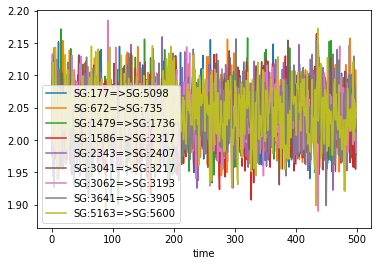
You could use the pandas plotting functions to make this a bit prettier, e.g.
>>> ax = df.plot(x="time", y=sr.colnames(bonds))
>>> ax.set_xlabel(f"Time / {df.time_unit()}")
>>> ax.set_ylabel(f"Size / {df.measure_unit()}")
>>> ax.legend(bbox_to_anchor=(1.05, 1.0))
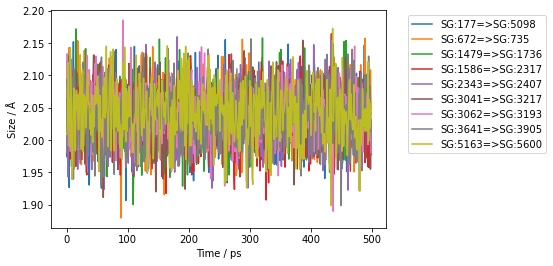
To make things easier, the above code is automatically added to the
dataframe returned by the .measures() function as
df.pretty_plot(), e.g.
>>> df.pretty_plot()

You can specify the x and y columns to use, e.g. here
we plot the sizes of the first two bonds against frame index.
>>> df.pretty_plot(x="frame", y=sr.colnames(bonds[0:1]))
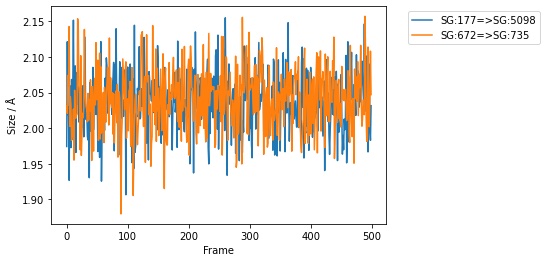
You could also collapse this all down to a single line, e.g. here plotting the first two bonds from every 20th frame of the trajectory;
>>> bonds[0:2].trajectory()[0::20].measures(to_pandas=True).pretty_plot()
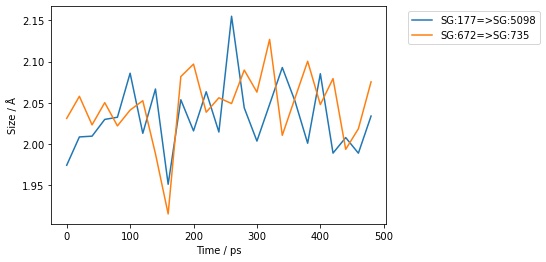
Measuring angles, dihedrals and impropers¶
You can measure angles, dihedrals and impropers across trajectories
in the same way that you do for bonds. Simply call the .trajectory()
function on the molecule view and then either iterate through the
frames manually…
>>> angles = mol.angles("element S", "element S", "element C")[0:3]
>>> for frame in angles.trajectory()[0::100]:
... print(frame, frame.measures())
SelectorAngle( size=3
0: Angle( CB:174 <= SG:177 => SG:5098 )
1: Angle( SG:177 <= SG:5098 => CB:5095 )
2: Angle( CB:669 <= SG:672 => SG:735 )
) [100.647°, 107.789°, 102.658°]
SelectorAngle( size=3
0: Angle( CB:174 <= SG:177 => SG:5098 )
1: Angle( SG:177 <= SG:5098 => CB:5095 )
2: Angle( CB:669 <= SG:672 => SG:735 )
) [108.425°, 108.255°, 102.161°]
SelectorAngle( size=3
0: Angle( CB:174 <= SG:177 => SG:5098 )
1: Angle( SG:177 <= SG:5098 => CB:5095 )
2: Angle( CB:669 <= SG:672 => SG:735 )
) [107.449°, 103.456°, 106.716°]
SelectorAngle( size=3
0: Angle( CB:174 <= SG:177 => SG:5098 )
1: Angle( SG:177 <= SG:5098 => CB:5095 )
2: Angle( CB:669 <= SG:672 => SG:735 )
) [108.96°, 102.244°, 105.909°]
SelectorAngle( size=3
0: Angle( CB:174 <= SG:177 => SG:5098 )
1: Angle( SG:177 <= SG:5098 => CB:5095 )
2: Angle( CB:669 <= SG:672 => SG:735 )
) [113.027°, 101.141°, 110.331°]
SelectorAngle( size=3
0: Angle( CB:174 <= SG:177 => SG:5098 )
1: Angle( SG:177 <= SG:5098 => CB:5095 )
2: Angle( CB:669 <= SG:672 => SG:735 )
) [106.493°, 103.807°, 101.657°]
…or use the .measures() function and convert to a pandas dataframe.
>>> df = angles.trajectory().measures(to_pandas=True)
>>> print(df)
frame time CB:174<=SG:177=>SG:5098 SG:177<=SG:5098=>CB:5095 CB:669<=SG:672=>SG:735
0 0 0.0 100.646778 107.789097 102.658280
1 1 0.0 106.123591 102.032015 103.878155
2 2 1.0 104.469532 96.718841 106.618866
3 3 2.0 96.850748 106.560527 109.500329
4 4 3.0 111.521915 107.566346 102.349405
.. ... ... ... ... ...
496 496 495.0 107.866246 101.751753 106.915247
497 497 496.0 104.664555 105.813593 103.434050
498 498 497.0 99.855355 103.378153 112.463535
499 499 498.0 111.433986 105.148629 107.430144
500 500 499.0 106.493204 103.807238 101.656993
[501 rows x 5 columns]
Plotting works in the same way too.
>>> angles.trajectory()[0::20].measures(to_pandas=True).pretty_plot()
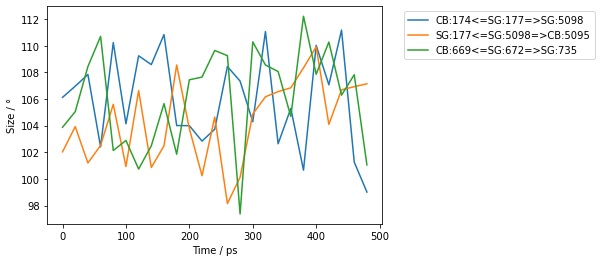
Performing arbitrary measurements¶
You can also perform arbitrary measurements across frames of a trajectory. The simplest way to do this is to just iterate over the desired frames. For example, lets calculate the distance between the centers of mass of the first and last residues in the molecule every 100 frames.
>>> for residues in mol.residues().trajectory()[0::100]:
... print(sr.measure(residues[0], residues[-1]))
45.6897 Å
43.1249 Å
16.5617 Å
48.1862 Å
37.0401 Å
60.8125 Å
Another way to do this is to use the .measures function, this time
passing in the function to perform the measurement.
>>> df = mol.residues().trajectory().measures(
... lambda residues: sr.measure(residues[0], residues[-1]),
... to_pandas=True)
>>> print(df)
frame time custom
0 0 0.0 44.216253
1 1 1.0 46.734178
2 2 2.0 45.378243
3 3 3.0 46.019010
4 4 4.0 80.861715
.. ... ... ...
495 495 495.0 42.214334
496 496 496.0 38.257463
497 497 497.0 61.065931
498 498 498.0 58.582622
499 499 499.0 60.812486
[500 rows x 3 columns]
Notice how the custom measurement is placed into a column called
custom. You can control the name by passing in a dictionary
of column name / function pairs, e.g.
>>> df = mol.residues().trajectory().measures({
... "distance" : lambda residues: sr.measure(residues[0], residues[-1]),
... }, to_pandas=True)
>>> print(df)
frame time distance
0 0 0.0 44.216253
1 1 1.0 46.734178
2 2 2.0 45.378243
3 3 3.0 46.019010
4 4 4.0 80.861715
.. ... ... ...
495 495 495.0 42.214334
496 496 496.0 38.257463
497 497 497.0 61.065931
498 498 498.0 58.582622
499 499 499.0 60.812486
[500 rows x 3 columns]
You can pass in as many column name / function pairs as you want to evaluate. Here we will calculate the distance between the first and last residues, and the distance between these two residues and the center of mass of the molecule.
>>> df = mol.residues().trajectory().measures({
... "distance" : lambda residues: sr.measure(residues[0], residues[-1]),
... "first_to_center": lambda residues: sr.measure(residues[0], residues.molecule()),
... "last_to_center": lambda residues: sr.measure(residues[-1], residues.molecule()),
... }, to_pandas=True)
>>> print(df)
frame time distance first_to_center last_to_center
0 0 0.0 44.216253 25.547407 62.515619
1 1 1.0 46.734178 25.095689 62.580996
2 2 2.0 45.378243 25.544252 61.655505
3 3 3.0 46.019010 26.016608 57.752940
4 4 4.0 80.861715 25.535940 63.151461
.. ... ... ... ... ...
495 495 495.0 42.214334 26.030188 31.460664
496 496 496.0 38.257463 26.851858 32.806361
497 497 497.0 61.065931 27.685484 47.324784
498 498 498.0 58.582622 26.512745 46.317341
499 499 499.0 60.812486 26.131392 44.847973
[500 rows x 5 columns]
You can, of course, plot this just as you did for simple measurements.
>>> df.pretty_plot()
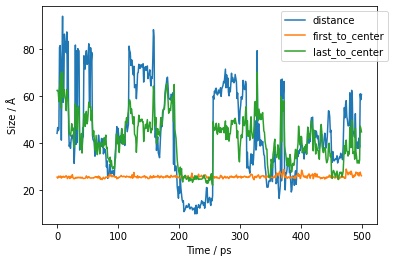
Creating tables of RMSDs using Pandas¶
Similarly, you can create tables of RMSDs using pandas. To do this,
pass to_pandas=True to the rmsd() function.
>>> df = mol.trajectory().rmsd(to_pandas=True)
>>> print(df)
frame time rmsd
0 0 0.0 0.000000
1 1 1.0 1.115236
2 2 2.0 1.117770
3 3 3.0 1.681272
4 4 4.0 2.000726
.. ... ... ...
495 495 495.0 2.153361
496 496 496.0 2.177437
497 497 497.0 2.055585
498 498 498.0 2.151492
499 499 499.0 2.146644
[500 rows x 3 columns]
You can also plot this, just as you did for simple measurements.
>>> df.pretty_plot()
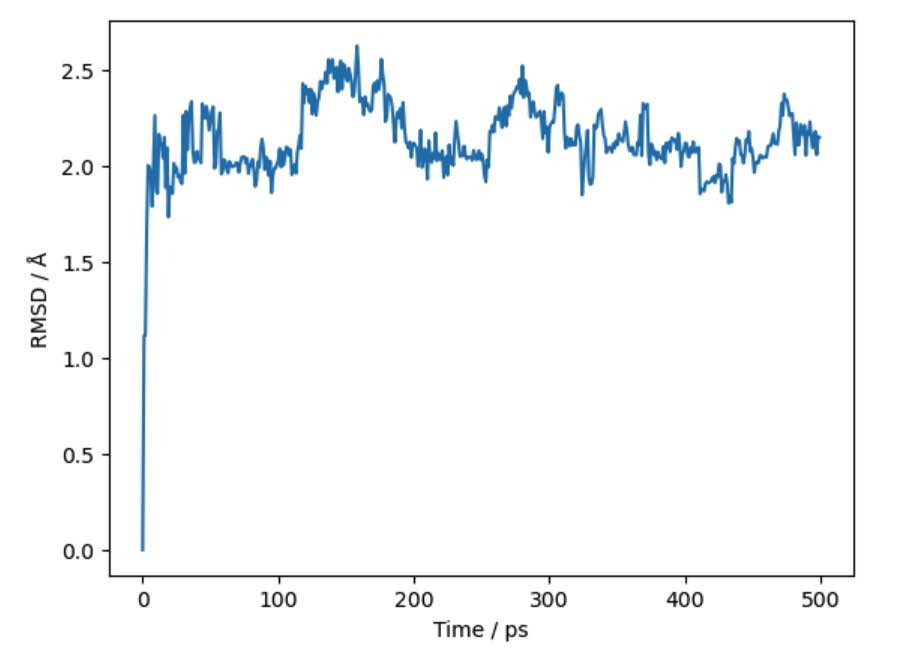
Note
You can learn more about trajectories, including how to align frames of a trajectory against arbitrary atoms, how to wrap molecules into the same periodic box, and how to smooth (average) coordinates across frames in this cheatsheet guide (in the section on viewing 3D trajectories).